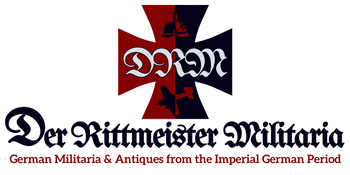Saxe-Meiningen (Herzogtum Sachsen-Meiningen)
CLICK HERE FOR ALL PRODUCTS RELATED TO SAXE MEININGEN
Basic Information
- Official Name: Duchy of Saxe-Meiningen (Herzogtum Sachsen-Meiningen)
- Capital: Meiningen
- Motto: "Honi soit qui mal y pense" (Shame on him who thinks evil of it)
- Established: 1681 as a duchy under the Ernestine Wettin line
- Dissolution: Transitioned to the Free State of Saxe-Meiningen in 1918 following the abdication of Duke Bernhard III.
-
Key Symbols:
- Coat of Arms: Features a green crown of rue on a shield divided into gold and black.
- Flag: Green and white horizontal stripes.
Geographical Overview
-
Location:
Located in central Germany, bordered by Prussia, Bavaria, and other Saxon duchies. Key towns included Meiningen, Hildburghausen, and Sonneberg. -
Size:
A small state with a mix of agricultural land, forests, and mountainous regions. -
Land Features:
- Thuringian Forest: A densely wooded mountain range rich in natural resources and tourism opportunities.
- Werra River: A vital waterway supporting agriculture and trade.
Historical Timeline
-
Early Saxe-Meiningen:
- 1681: Established following the division of the Ernestine Saxon lands.
- 19th Century: Known as the “Theater Duchy” for its patronage of the performing arts and music.
-
Duchy Era (1681–1918):
- Expanded its cultural influence through ties to other Saxon duchies and German states.
- 1871: Became part of the German Empire while retaining internal autonomy.
-
Decline (1918):
- The abdication of Duke Bernhard III during the German Revolution marked the end of the duchy, transitioning into the Free State of Saxe-Meiningen.
Notable Rulers and Leaders
- Georg I (1782–1803): A patron of the arts who laid the foundation for Meiningen’s cultural legacy.
- Georg II (1866–1914): Known as the “Theater Duke,” he revolutionized stagecraft and promoted the Meiningen Ensemble, a world-renowned theater troupe.
- Bernhard III (1914–1918): The last duke, whose reign ended with the German Revolution.
Military and Political Strength
-
Military Contributions:
- Saxe-Meiningen contributed regiments to the Imperial German Army, particularly in infantry and engineering units.
- Known for its support of Prussia during the unification wars.
-
Political Role:
- Governed as a constitutional monarchy with representation in the German Empire’s Bundesrat.
- Played a minor but culturally significant role within the empire.
Cultural Contributions
-
Architecture:
- Elisabethenburg Palace: A Baroque palace in Meiningen, serving as the ducal residence and a cultural hub.
- Theater in Meiningen: A leading institution for drama and stagecraft in Europe.
-
Arts and Music:
- The Meiningen Ensemble, led by Georg II, set new standards in theatrical production, influencing European drama.
- Supported Romantic composers, including Johannes Brahms, who often collaborated with Meiningen’s court orchestra.
-
Education and Science:
- Focused on public education and cultural institutions.
- Sponsored early forestry and ecological studies, reflecting the region’s reliance on natural resources.
-
Cuisine:
- Known for Thuringian dumplings and game dishes, reflecting its forested landscape.
- Traditional sweets like Sachsen-Kuchen (a type of fruit cake) were popular in local celebrations.
Fall of Saxe-Meiningen
-
World War I (1914–1918):
- The war caused significant economic strain and social unrest in the duchy.
-
German Revolution (1918):
- Duke Bernhard III abdicated, and Saxe-Meiningen transitioned into a Free State before merging into Thuringia in 1920.
-
Post-WWII (1945):
- Incorporated into East Germany and later into modern Thuringia after reunification.
Connections to Products
-
Cultural Artifacts:
- Memorabilia from the Meiningen Ensemble, including theater posters and programs.
- Replicas of Elisabethenburg Palace and other historical buildings.
-
Military Memorabilia:
- Regimental medals and badges from the duchy’s contributions to the Imperial Army.
- Uniforms and ceremonial swords linked to Saxe-Meiningen’s military history.
-
Historical Documents:
- Treaties, maps, and administrative records from the duchy’s governance.
- Correspondence and publications related to Georg II’s theater reforms.
-
Tourism and Culinary Items:
- Guidebooks and postcards featuring landmarks like Elisabethenburg Palace and the Meiningen Theater.
- Recipe books and tools for preparing Thuringian dumplings and traditional game dishes.
-
Educational Contributions:
- Historical publications on forestry and ecological studies sponsored by the duchy.
- Records and artifacts from Meiningen’s public education initiatives.









